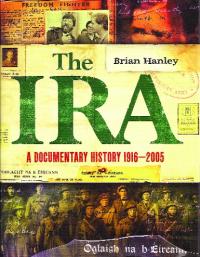The IRA: a documentary history 1916–2005
Published in 20th-century / Contemporary History, Book Reviews, Issue 1 (Jan/Feb 2011), Reviews, Volume 19
The IRA: a documentary history 1916–2005
Brian Hanley
(Gill & Macmillan, €24.99)
ISBN 9780717148134
Over the past four decades, beginning with Tim Pat Coogan’s The IRA and J. Bowyer Bell’s The secret army, the IRA in its various mutations has been the subject of a vast range of books of varying quality. The historiography of the republican movement up to 1969 has developed over time, as more records and other material have become available. Personal recollections, partisan accounts and sporadic newspaper coverage no longer constitute the only sources available. Brian Hanley’s first book, The IRA 1926–1936 (2002)—a work which, whether through excessive modesty or simple oversight, he omits from the otherwise useful select bibliography—is a good example of how the written history of twentieth-century Irish republicanism has changed. Once based largely on folklore and late night anecdote, it now draws on a broad assembly of evidence. Increased access to Irish, British and American government records, and to collections held for decades in private hands, such as the Moss Twomey papers that Hanley used so extensively, enables historians to offer far more nuanced explorations of the history of twentieth-century Irish republicanism and to place the narrative in a wider national and international political context.
Hanley’s latest work, The IRA: a documentary history 1916–2005, supplies a concise text providing a useful guide to the vicissitudes of physical-force republicanism since 1916, which broadly manages to clarify rather than oversimplify or unduly sentimentalise the IRA’s history. The supporting illustrations are, however, cumulatively somewhat disappointing.
I would have liked a little more reflection on some aspects of the story, including the IRA’s curious international links over the decades. In the 1920s the Soviet Union offered a vision of socialism that appealed to a minority of the movement’s intelligentsia. In the same era the IRA itself became a kind of private espionage agency, spying for Moscow in Britain, France and the United States in return for the cash needed to finance its headquarters operations (as Tom Mahon and J.J. Gilgooly detailed in Decoding the IRA (2008), based on their reading of extensive coded correspondence in the Twomey papers). Yet within a decade the IRA was casting hopeful eyes at Hitler’s Germany. German support was pursued both for pragmatic reasons and—at least for a handful of those involved, including James O’Donovan, the subject of David O’Donoghue’s newly published The Devil’s disciple—on ideological grounds. O’Donovan was the author of the grandiose ‘S Plan’ on which the 1939 campaign of bombing in Britain was based, and an extract from that curious pseudo-strategic document would have been useful. So too would material from the 1960s and 1970s, illustrating how the following generation of republicans of various stripes conceptualised their struggle and related their strategy and tactics to wars of decolonisation, national liberation and ethnic division elsewhere.
Hanley explains his selection of illustrations by pointing out that ‘the internal [IRA] documentation is very heavily weighted towards the 1920s and 1930s’. His choice of material for reproduction even from that era was probably determined by questions of copyright or access. Under Richard Mulcahy, chief-of-staff from 1918 to 1921, IRA GHQ developed relatively sophisticated processes intended to replicate the organisation of a conventional army. While a number of 1919–23 GHQ documents and published statements are attractively reproduced in colour (Hanley draws on material in the Sighle Humphreys papers, including what are effectively a subset of carbons of documents also to be found in the Mulcahy collection), en masse these are likely to appeal more to historians accustomed to the single-spaced prolixity that characterised many republican documents than to a general audience. Most of the documents displayed from the 1919–23 period reflect the organisational culture of the IRA at the higher levels, rather than its on-the-ground activities, experience and efforts to intimidate its enemies: it would have been interesting to have a ‘Spies Beware!’ notice, perhaps.
The documents from the later period are somewhat disappointing, being mainly reproductions of pages from the republican press, an occasional poster and familiar press photographs of riot-torn Belfast streets and the like. While a purist might smell fabrication, it would have been useful to include IRA material now available in state records, such as the planning document seized by the Special Branch in 1966 when a leading republican was arrested. There is, however, one shining exception to my complaint. Hanley has managed to get his hands on the execrably typed minutes of the Official IRA convention of October 1972, at which the ‘Stickies’, reeling from the self-inflicted calamity of the Aldershot bombing, inconclusively debated the way forward (as Hanley’s recent The lost revolution (2009) describes, they subsequently opted out of armed struggle for good, while retaining an undeclared armed wing, which facilitated divergent sideways moves by erstwhile comrades into gangsterism and electoral activism).
No doubt as a result of pressure from the publisher, this book is awkwardly positioned somewhere between the coffee table and the library shelf. It works far better as a concise history of the IRA than as an illustrated guide to its documentary spoor. HI
















